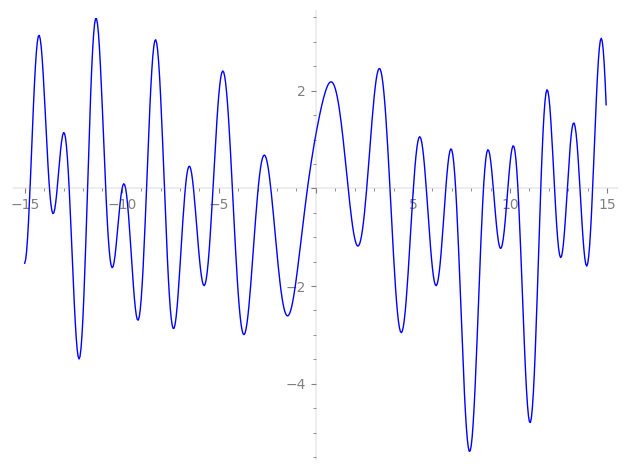| L(s) = 1 | + (2.12 + 0.692i)5-s + (−2.46 − 0.950i)7-s + (−0.454 − 0.787i)11-s + (−2.98 − 2.98i)13-s + (−3.71 − 0.994i)17-s + (0.735 − 1.27i)19-s + (−1.80 − 6.73i)23-s + (4.03 + 2.94i)25-s − 9.63i·29-s + (2.31 − 1.33i)31-s + (−4.59 − 3.73i)35-s + (−0.538 + 0.144i)37-s + 3.86i·41-s + (−7.99 + 7.99i)43-s + (−1.88 − 7.03i)47-s + ⋯ |
| L(s) = 1 | + (0.950 + 0.309i)5-s + (−0.933 − 0.359i)7-s + (−0.137 − 0.237i)11-s + (−0.829 − 0.829i)13-s + (−0.900 − 0.241i)17-s + (0.168 − 0.292i)19-s + (−0.376 − 1.40i)23-s + (0.807 + 0.589i)25-s − 1.78i·29-s + (0.415 − 0.239i)31-s + (−0.776 − 0.630i)35-s + (−0.0885 + 0.0237i)37-s + 0.602i·41-s + (−1.21 + 1.21i)43-s + (−0.275 − 1.02i)47-s + ⋯ |
\[\begin{aligned}\Lambda(s)=\mathstrut & 1260 ^{s/2} \, \Gamma_{\C}(s) \, L(s)\cr =\mathstrut & (-0.252 + 0.967i)\, \overline{\Lambda}(2-s) \end{aligned}\]
\[\begin{aligned}\Lambda(s)=\mathstrut & 1260 ^{s/2} \, \Gamma_{\C}(s+1/2) \, L(s)\cr =\mathstrut & (-0.252 + 0.967i)\, \overline{\Lambda}(1-s) \end{aligned}\]
Particular Values
| \(L(1)\) |
\(\approx\) |
\(1.109240874\) |
| \(L(\frac12)\) |
\(\approx\) |
\(1.109240874\) |
| \(L(\frac{3}{2})\) |
|
not available |
| \(L(1)\) |
|
not available |
\(L(s) = \displaystyle \prod_{p} F_p(p^{-s})^{-1} \)
| $p$ | $F_p(T)$ |
|---|
| bad | 2 | \( 1 \) |
| 3 | \( 1 \) |
| 5 | \( 1 + (-2.12 - 0.692i)T \) |
| 7 | \( 1 + (2.46 + 0.950i)T \) |
| good | 11 | \( 1 + (0.454 + 0.787i)T + (-5.5 + 9.52i)T^{2} \) |
| 13 | \( 1 + (2.98 + 2.98i)T + 13iT^{2} \) |
| 17 | \( 1 + (3.71 + 0.994i)T + (14.7 + 8.5i)T^{2} \) |
| 19 | \( 1 + (-0.735 + 1.27i)T + (-9.5 - 16.4i)T^{2} \) |
| 23 | \( 1 + (1.80 + 6.73i)T + (-19.9 + 11.5i)T^{2} \) |
| 29 | \( 1 + 9.63iT - 29T^{2} \) |
| 31 | \( 1 + (-2.31 + 1.33i)T + (15.5 - 26.8i)T^{2} \) |
| 37 | \( 1 + (0.538 - 0.144i)T + (32.0 - 18.5i)T^{2} \) |
| 41 | \( 1 - 3.86iT - 41T^{2} \) |
| 43 | \( 1 + (7.99 - 7.99i)T - 43iT^{2} \) |
| 47 | \( 1 + (1.88 + 7.03i)T + (-40.7 + 23.5i)T^{2} \) |
| 53 | \( 1 + (-11.9 - 3.19i)T + (45.8 + 26.5i)T^{2} \) |
| 59 | \( 1 + (5.62 + 9.74i)T + (-29.5 + 51.0i)T^{2} \) |
| 61 | \( 1 + (-8.84 - 5.10i)T + (30.5 + 52.8i)T^{2} \) |
| 67 | \( 1 + (-2.62 + 9.80i)T + (-58.0 - 33.5i)T^{2} \) |
| 71 | \( 1 + 1.59T + 71T^{2} \) |
| 73 | \( 1 + (0.345 - 1.29i)T + (-63.2 - 36.5i)T^{2} \) |
| 79 | \( 1 + (1.52 + 0.878i)T + (39.5 + 68.4i)T^{2} \) |
| 83 | \( 1 + (4.29 + 4.29i)T + 83iT^{2} \) |
| 89 | \( 1 + (4.16 - 7.22i)T + (-44.5 - 77.0i)T^{2} \) |
| 97 | \( 1 + (-1.77 + 1.77i)T - 97iT^{2} \) |
| show more | |
| show less | |
\(L(s) = \displaystyle\prod_p \ \prod_{j=1}^{2} (1 - \alpha_{j,p}\, p^{-s})^{-1}\)
Imaginary part of the first few zeros on the critical line
−9.801123529613924053524288138132, −8.723652283327213930498416206146, −7.80036389628808716127155024504, −6.72661351277434251566855386594, −6.30647721370096821757072563701, −5.30083369494485721995270625616, −4.30165975685056758100449837242, −2.97384257571111173958347697520, −2.32328919456481661915135850422, −0.43512753530116955454581282417,
1.66369082670105187753830250918, 2.61676829471386943745531693076, 3.81512783611278365868477721384, 5.02001268289191113376109518081, 5.68546009990494309890177571924, 6.69155816417462943688705961273, 7.19805838320119347390555273160, 8.631962742876955230313564734402, 9.138449647298263681832706599360, 9.886992272884773485560688895643

